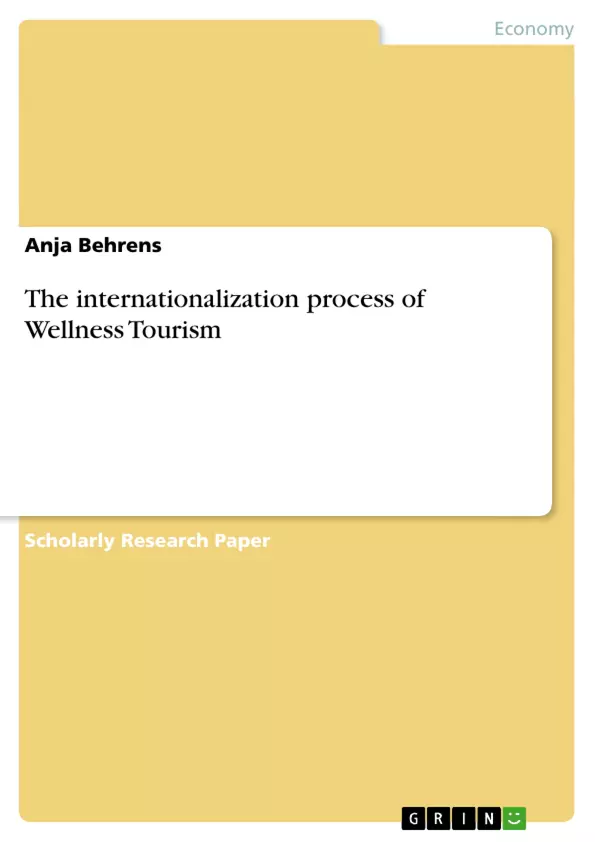During the last decades wellness tourism has been booming worldwide. Stimulated by an in-creased interest in health and fitness as well as the need to escape from work-related stress, “spa-going” is now one of the most sophisticated and exciting ways of making holidays in the 21st century.
Responding to the increasing demand for wellness, the tourism industry had to adapt its holi-day offers and hotel facilities by creating spa or wellness centres within the hotels and resorts – spa or wellness centres which opened in the cities recently are not entering the field of well-ness tourism and therefore are not recognized in this report.
In this report the identification of wellness tourism, its development and its trends are the matter of interest. After the definition of wellness tourism we will delimit its components and some concepts in close relation.
In a second step we will explain the international development of wellness tourism which means the underlying mentality changes and its reasons, the history and development of well-ness tourism and the international expansion of spa.
The internationalization grade of wellness tourism will be worked out in the third part by giv-ing information about the most important sending and receiving countries, brand philosophies of wellness hotels and international associations of spa and wellness.
In the last part of the report we will describe trends of wellness tourism related to the overall demand and offer as well as the most significant motives of the wellness tourist choosing a tourist destination.
Inhaltsverzeichnis (Table of Contents)
- ABBREVATIONS
- INTRODUCTION
- OVERVIEW: BASIC DEFINITIONS
- THE WELLNESS CONCEPT
- TYPOLOGY OF SPA & WELLNESS INSTALLATIONS
- THE CONCEPT OF WELLNESS TOURISM
- INTERNATIONAL DEVELOPMENT OF WELLNESS TOURISM
- WELLNESS AND LIFESTYLE CHANGES
- SOME FACTORS CONTRIBUTING TO THE GROWTH OF WELLNESS TOURISM
- DEVELOPMENT OF WELLNESS TOURISM
- THE INTERNATIONAL EXPANSION OF SPA
- GRADE OF INTERNATIONALIZATION OF WELLNESS TOURISM
- PRINCIPAL SENDING COUNTRIES
- PRINCIPAL RECEIVING COUNTRIES
- BRAND PHILOSOPHIES OF WELLNESS HOTELS AND INTERNATIONAL ASSOCIATIONS OF SPA AND WELLNESS
- TRENDS OF WELLNESS TOURISM AND MOST IMPORTANT FACTORS INFLUENCING THE DEMAND
- TRENDS OF WELLNESS TOURISM (DEMAND)
- MOST IMPORTANT FACTORS FOR THE WELLNESS TOURISTS
- TRENDS OF WELLNESS TOURISM (OFFER)
- CONCLUSION
- REFERENCES
- APPENDIX
Zielsetzung und Themenschwerpunkte (Objectives and Key Themes)
This report aims to define and analyze the concept of wellness tourism, its development, and current trends. It explores the factors influencing its growth, examines the internationalization process, and delves into the motivations of wellness tourists.
- Definition and differentiation of health and wellness
- International development and expansion of wellness tourism
- Analysis of key sending and receiving countries
- Brand philosophies of wellness hotels and international associations
- Trends and factors influencing demand and supply within the wellness tourism sector
Zusammenfassung der Kapitel (Chapter Summaries)
The report begins with a comprehensive overview of the concepts of wellness, wellness tourism, and related terms. It then explores the international development of wellness tourism, analyzing the driving forces behind its growth, historical evolution, and expansion of spa facilities worldwide.
The third section focuses on the internationalization of wellness tourism by examining major sending and receiving countries, highlighting brand philosophies of leading wellness hotels, and discussing key international associations.
The final section examines the trends within the wellness tourism sector, focusing on factors influencing both demand and supply. It investigates the motivations of wellness tourists and analyzes the offerings within the industry.
Schlüsselwörter (Keywords)
Wellness tourism, health and wellness, internationalization, spa, trends, demand, supply, brand philosophy, associations.
- Citation du texte
- Anja Behrens (Auteur), 2007, The internationalization process of Wellness Tourism, Munich, GRIN Verlag, https://www.grin.com/document/130160



